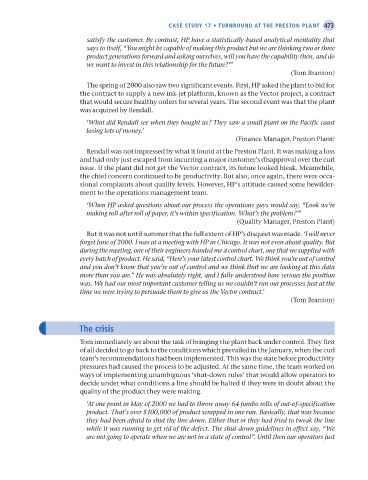Page 498 - Operations Strategy
P. 498
case study 17 • turnround at the Preston Plant 473
satisfy the customer. By contrast, HP have a statistically-based analytical mentality that
says to itself, “You might be capable of making this product but we are thinking two or three
product generations forward and asking ourselves, will you have the capability then, and do
we want to invest in this relationship for the future?”’
(Tom Branton)
The spring of 2000 also saw two significant events. First, HP asked the plant to bid for
the contract to supply a new ink-jet platform, known as the Vector project, a contract
that would secure healthy orders for several years. The second event was that the plant
was acquired by Rendall.
‘What did Rendall see when they bought us? They saw a small plant on the Pacific coast
losing lots of money.’
(Finance Manager, Preston Plant)
Rendall was not impressed by what it found at the Preston Plant. It was making a loss
and had only just escaped from incurring a major customer’s disapproval over the curl
issue. If the plant did not get the Vector contract, its future looked bleak. Meanwhile,
the chief concern continued to be productivity. But also, once again, there were occa-
sional complaints about quality levels. However, HP’s attitude caused some bewilder-
ment to the operations management team.
‘When HP asked questions about our process the operations guys would say, “Look we’re
making roll after roll of paper, it’s within specification. What’s the problem?”’
(Quality Manager, Preston Plant)
But it was not until summer that the full extent of HP’s disquiet was made. ‘I will never
forget June of 2000. I was at a meeting with HP in Chicago. It was not even about quality. But
during the meeting, one of their engineers handed me a control chart, one that we supplied with
every batch of product. He said, “Here’s your latest control chart. We think you’re out of control
and you don’t know that you’re out of control and we think that we are looking at this data
more than you are.” He was absolutely right, and I fully understood how serious the position
was. We had our most important customer telling us we couldn’t run our processes just at the
time we were trying to persuade them to give us the Vector contract.’
(Tom Branton)
The crisis
Tom immediately set about the task of bringing the plant back under control. They first
of all decided to go back to the conditions which prevailed in the January, when the curl
team’s recommendations had been implemented. This was the state before productivity
pressures had caused the process to be adjusted. At the same time, the team worked on
ways of implementing unambiguous ‘shut-down rules’ that would allow operators to
decide under what conditions a line should be halted if they were in doubt about the
quality of the product they were making.
‘At one point in May of 2000 we had to throw away 64 jumbo rolls of out-of-specification
product. That’s over $100,000 of product scrapped in one run. Basically, that was because
they had been afraid to shut the line down. Either that or they had tried to tweak the line
while it was running to get rid of the defect. The shut-down guidelines in effect say, “We
are not going to operate when we are not in a state of control”. Until then our operators just
Z17 Operations Strategy 62492.indd 473 02/03/2017 14:01

